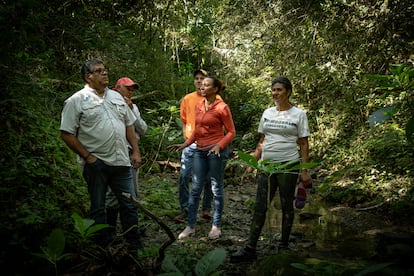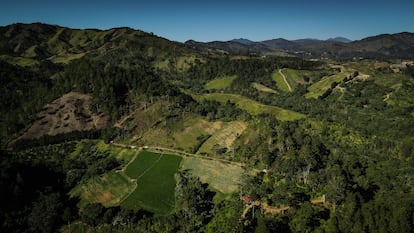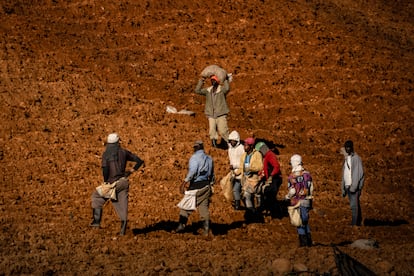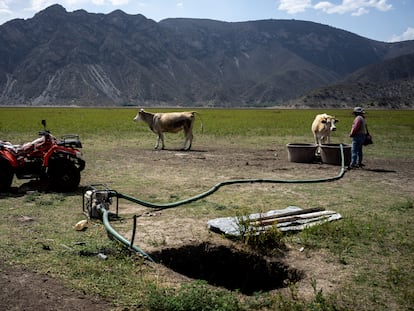The Dominican Republic miracle: a fifth of the country regreened in 10 years
The Yaque River basin restoration project has reduced soil degradation by 18%, although gentrification and climate change remain threats


Carlos Rodríguez has spent “his entire life” taking care of Don Franklin’s farm. In a small corner of the municipality of La Pelada in the heart of the Dominican Republic the 53-year-old farmer knows the “two-thousand-odd” acres of land like the back of his hand. Today, with his hands behind his back and his gaze full of pride, he admires the land that he has tended for decades. From the neighboring sandy terrain of the El Negro estate, you can see the hill covered by thousands of interspersed cedars, Creole pines, and cypresses that expose nothing of the soil beneath them. He looks at it like a father looks at his grown children. We can no longer even guess the paths that Dulce María Fabián and Yakaira Rodríguez traced 15 years ago, when they set out to revive this terrain that was at that time a wasteland.
The two mountain estates have faced each other for centuries. At some point, Don Franklin and El Negro — who did not want to repopulate his estate with trees — had pristine land. It remained untouched until the 15th century, when hundreds of Dominicans began to live off the mountains without knowing very well how to do it. The exodus to the countryside was desperate. People were in a rush to live off what the land produced, in a country more accustomed to the sea than the forest. Dominicans know it as the “slash and burn” era. Thus began a “use” of the land that ended up squeezing the every last benefit out of the territory. Population growth and uncontroled tourism made maintaining biodiversity in the the Dominican Republic unsustainable. That is why, in 2015, almost half of the Caribbean country’s land had been degraded and hundreds of families were forced to move again. But now Dominicans also migrated overseas.

Six years before these painful figures from the United Nations Convention to Combat Desertification (UNCCD) came to light, Humberto Chaco was already trying to plug this ecological drain. “It was obvious. The mountains were left bare because the wood had been sold, people were raising livestock, or cultivating crops. We had to do something,” he says from the wheel of his white van in which he has crisscrossed the country a thousand and one times. Thus, in 2009 they decided to launch the Plan for the Development of the Yaque del Norte River Basin (Plan Yaque), an NGO that brings together thirty organizations from the state and civil society to protect the basin of the largest river in the Dominican Republic. The river runs for 185 miles through the island and supplies the country with water as best it can.
Although the Dominican Republic is an island, water is a precious and impermanent commodity. According to Chaco’s estimates, the variability of the flow is increasing. That is, between the rainy season and summer, the river gains or loses 80% of its water. “This is an indicator of the absolute deterioration of the basin,” he says. “In a healthy basin, this percentage would be 20%.” Increasingly longer droughts and more intense rains have unbalanced many of the water cycles; Climate change has also left its mark here. Another problem is the lack of forest cover. In a biodiverse ecosystem, trees retain rainfall like a sponge and dose it out little by little. Without them, the rainwater drains away like water off a duck’s back.
Spreading the word
Plan Yaque is as simple as it is efficient: convince landowners that reforesting their farms is also beneficial for them. After several community meetings in different areas of the country, Chaco and the rest of the team put together an army of community leaders who traveled around by the dozen in 19 of the 52 micro-basins of the Yaque River. Today they are at work in 16% of the territory. Everyone knew the beneficial effects reforestation had on the ecosystem and explained it farm by farm, owner by owner. The irregular access to water, which has been a headache for all Dominican farmers, also became the infallible argument to persuade them. “We are like priests evangelizing,” says Chaco, laughing.

“At first, the owners ask you: ‘what do I get out of all this planting trees on my land?’” says Dulce María Fabián Ortiz, 53 years old. “And when you explain to them that this is how they will ensure water in 10 or 15 years, they think more rationally.” This is what happened with Don Franklin who, according to Ortiz, is “very happy” with the results. For 15 years, his farm has seen its neighbor remain a perennial brown while on his land 50,000 trees were planted; moisture in the soil has been retained; and parrots, hummingbirds, and snakes have arrived to occupy their new home.
In 2019, after a decade of intense work from Plan Yaque and other environmental projects on the island, the country had restored 18% of the land that had been degraded since 2015. This is the second largest land recovery in Latin America, after Haiti. However, the organization has not been able to carry out an exhaustive analysis of this case due to a lack of comparable data.
Between 2016 and 2019, 21.89% (about 934 million acres) of land in Latin America had been degraded; a proportion that is approximately equivalent to three times the size of Colombia. For Andrea Meza, Deputy Executive Secretary of UNCCD, the Dominican Republic’s achievement is “impressive”: “It is an example that soil degradation can be reversed without it implying economic decline, as many would have us believe.” In 2010, the country had generated almost $54 billion; In 2019, its GDP reached $89 billion. “The most cost-effective thing is to have a healthy environment and make nature a great friend and ally”.
It is a vision that Ortiz shares. Like her, there are today about 280 community leaders throughout the country who earn about $146 per month for this valuable work. They begin by carefully choosing the properties that can be used, and agree with their owners what they would like it to be used for. “We all win,” says Yakaira Rodríguez López, 38, who is another of the leaders. Ortiz, Rodríguez, and eight other people chose which trees would repopulate the mountainside and how to set up a planting plan that would take less than three years. Today they visit the land after years without seeing it and remember all the effort they made. “But it was worth it, look at this stream, how clean and fast-flowing it is,” says Rodríguez on the banks of a small flow of icy water. “The ground stays moist now,” says Ortiz kneeling.
“They want to continue making ‘Punta Canas’ all over the country”
On the way to the farm that Carlos Rodríguez watches over, Chaco sees four bricklayers working at the end of the road. They are building a luxurious house with views of the immensity of the green, and the homeowner is watching from the side . He says that it is for a second residence and that he has been working all his life to be able to retire in a “quiet place like this.” “You are building your house in a place where there should only be trees,” Chaco snaps, visibly uncomfortable. “You think you’re not rich, but you are. And that is why you believe that you have the right to this other wealth,” he says. There are issues that irritate the forestry engineer and gentrification is one of them. “Tourists and the Dominican upper class have already devastated the beaches and are now going for the mountain areas. “They want to continue making Punta Canas all over the country.”
The Dominican Republic received more than seven million tourists between January and August 2023, 25% more than in the same period in 2022, according to data from the Ministry of Tourism. That is why the project technicians, likeJosefina Beltré, choose the properties they want to regreen with such precision. “We select sloping areas so that if the owners of the properties change their mind later, they won’t be able to change the use of the land and build a hotel or second homes. A farm like this could not later be used for livestock or extensive crops. “Reforestation is a way to protect these territories.” She adds: “Once it is reforested, it will never be seen naked again. Because you can take advantage of it but never leave it bare.” For Meza, this is one of the great pending issues for the region: “Countries have to commit to integrated land use planning, have good legal frameworks and the tools to implement them. Let’s not get confused, land management is not only a way to conserve, it is the way to choose the development we want. Basing our economy solely on extractive systems will only bring poverty, violence and migration to the region.”

Sign up for our weekly newsletter to get more English-language news coverage from EL PAÍS USA Edition









































